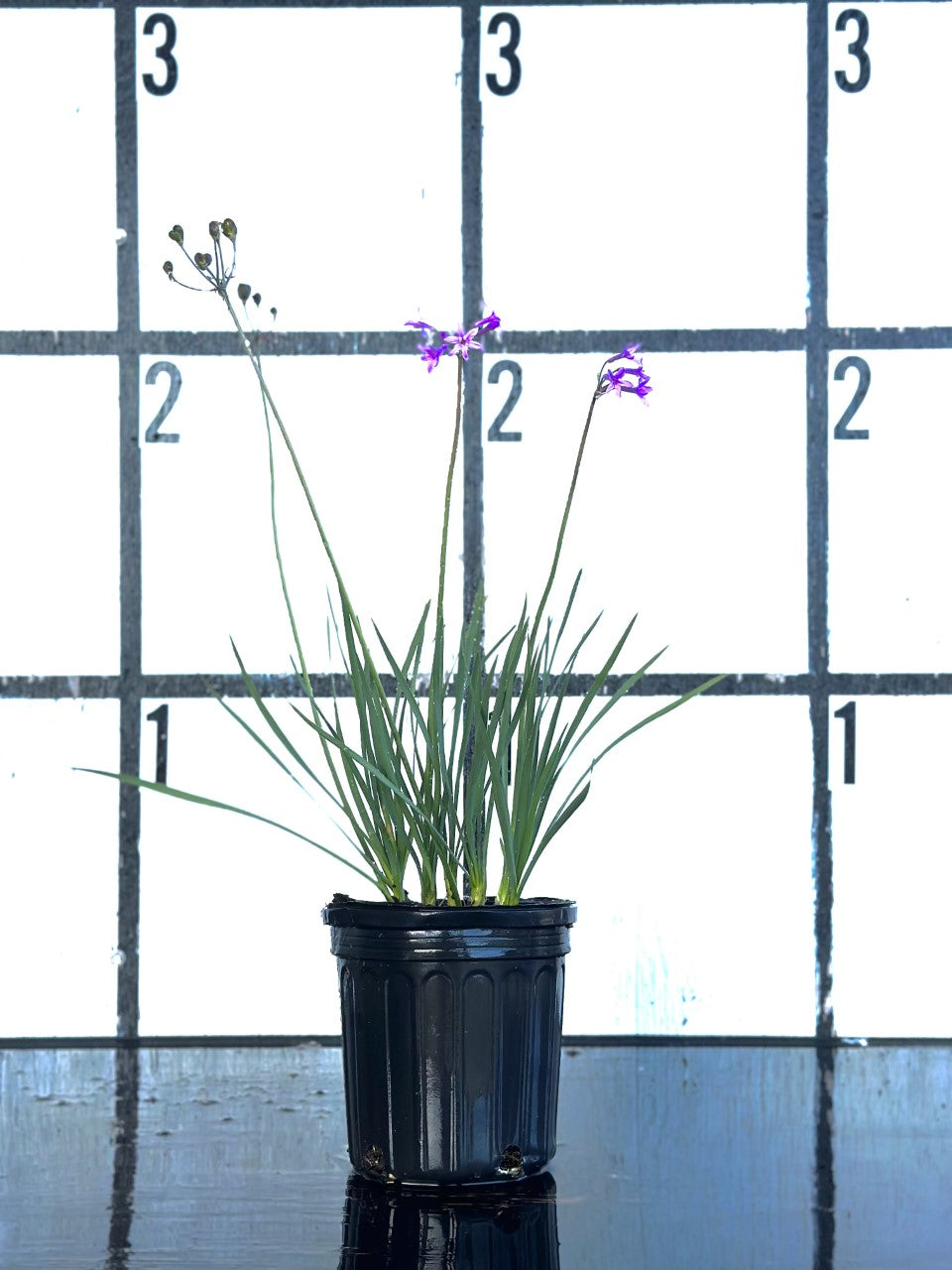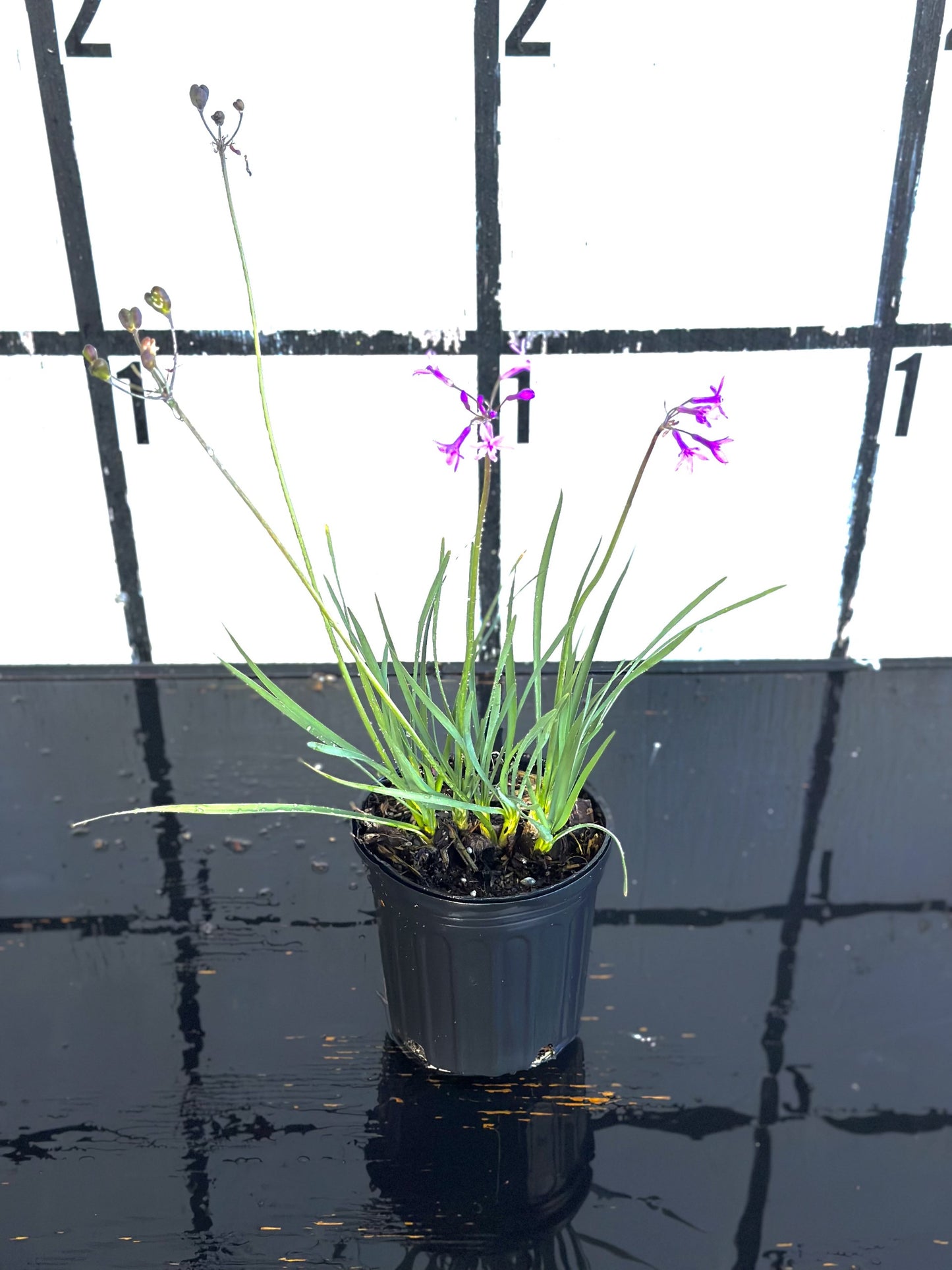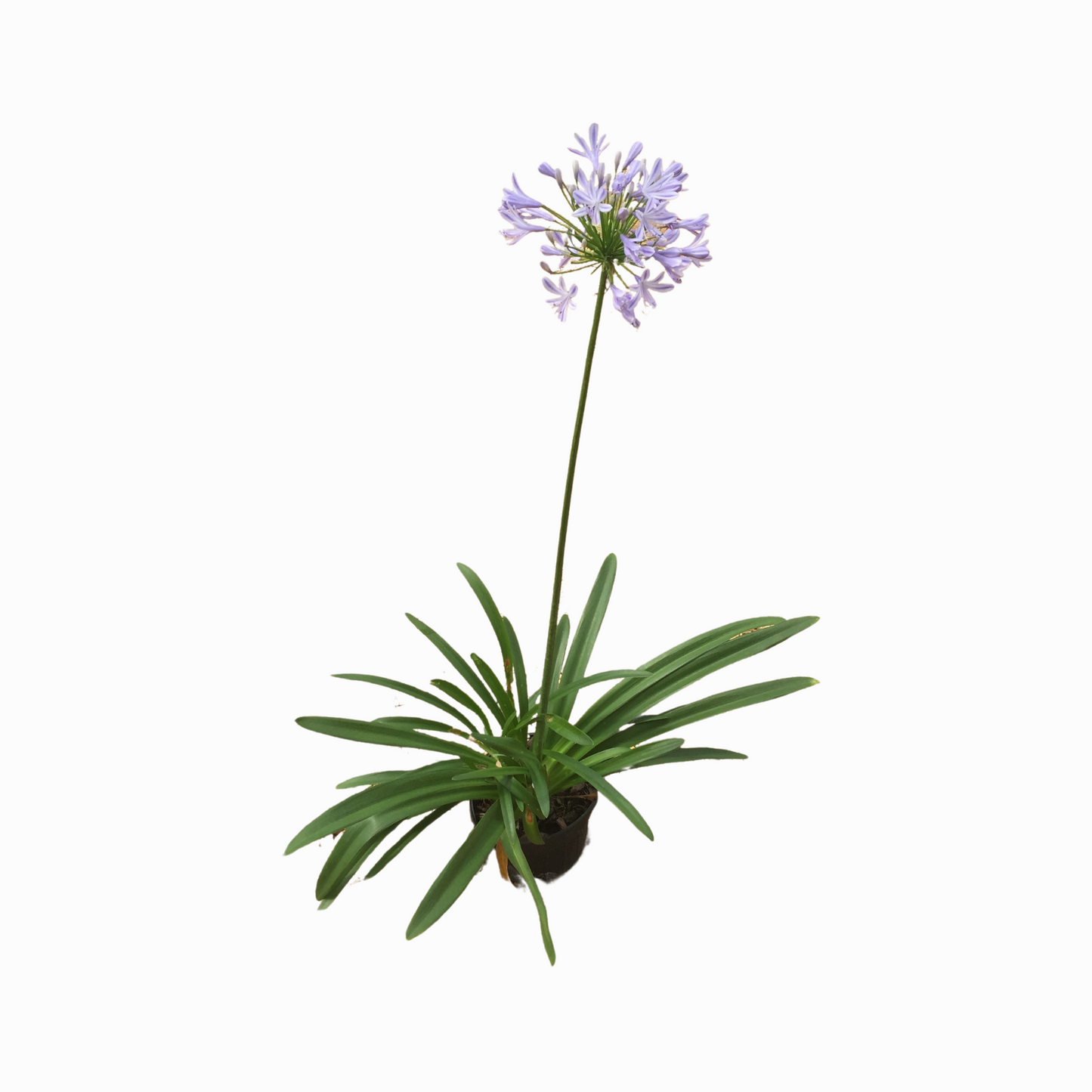Society Garlic
Society Garlic
4.43 / 5.0
(7) 7 total reviews
Couldn't load pickup availability
![]() Get it between -
Get it between -
Description
Description
Earning its name thanks to the garlic-like aroma from its leaves and the plant’s clump forming habit, the Society Garlic plant is great for planting in warmer climates since it tolerates the Summer heat especially well and blooms beautifully for months at a time. Boasting urn-shaped blooms just a bit less than an inch long each and grayish-green leaves that look especially great when you plant several of these gorgeous plants together, add some striking color and fragrance to your outdoor areas with one of more of these lovely lily-style plants to the mix. Plant your amazing Society Garlic plants in the ground in warmer climates or in a container in areas with colder times of the year and you can enjoy this incredible plant anywhere any time of the year. *May not arrive with blooms depending on current weather conditions and time of year*
Shipping & Returns
Shipping & Returns
Shipping:
Shipping live plants sometimes has its challenges when dealing with inclement weather but we strive to have every single order shipped out on their scheduled shipping date. Most orders will be scheduled to ship within 1-2 weeks of ordering. Because a plant needs TLC we only ship out on Mondays-Wednesdays to ensure the plants aren’t stationed somewhere over the weekend with no water or sunlight.
When to Ship:
We can ship out plants at anytime of the year pruned or not pruned, cold or not cold. Each plant’s durabilty is different so we recommend having them shipped in their designated season but we will still ship your plant to you earlier if you choose so.
Returns:
Because plants are perishable they cannot be returned without prior permission. We work hard to ensure all plants arrive healthy, but on rare occasions issues with the plant health upon delivery do arise.
Every single shipped plant is healthy upon departing our facility but if a plant is received in poor health contact us immediately so that we can assess the problem and work on saving the plant. We will first need a photo of the plant to start a claim. If we determine your plant cannot be recovered we will send you a replacement immediately. If notified of the plants health within 4 days we will send a replacement 100% free of charge.
If you determine the plant not to be healthy 4 days after delivery you can contact us and we will issue a 50% store credit.
30 days after delivery we cannot be held responsible for the current health of the plant.
Wholesale & Bulk Orders
Wholesale & Bulk Orders
To get started or learn more about our wholesale program and pricing please complete this form.






Questions & Answers
Have a Question?
-
how long do they live?
Society garlic plants can live several years in warmer climates with proper care, often lasting 3–5 years or more in ideal conditions.
-
is there any other color other than the pink that is edible
No, only the standard light pink or lilac-colored flowers are typically edible; these flowers have a mild garlic flavor.
-
Do these smell garlicky?
Yes, society garlic plants emit a garlicky aroma, especially when leaves or stems are crushed, making them a popular choice for natural pest deterrence.
-
Don't they attract flies?
Society garlic is not known to attract flies; in fact, the strong garlic scent may help keep some insects away.
-
When is the best time for pulling your bulbs for inside use
For indoor storage, dig up society garlic bulbs in late fall before the first frost and replant them outside after the last frost in spring.
-
Does it help deter deer from my other plants?
Yes, society garlic is often used to deter deer, as they typically dislike the garlic-like scent of the plant.
-
Does it keep snakes away.
While society garlic is sometimes rumored to repel snakes, there’s limited evidence to confirm this effect.
-
Does it grow an actual garlic bulb
Society garlic does not produce a true garlic bulb but has small rhizomes and roots instead.
-
Can it live indoor?
Yes, society garlic can be grown indoors in a sunny location, making it a good option for overwintering in colder climates.
-
Is society garlic perennials
Society garlic is a perennial in warmer climates (zones 7–10), coming back each year in suitable temperatures.
-
Is Garlic plant poisonous to dogs
Yes, society garlic is toxic to dogs if ingested, potentially causing symptoms like vomiting and digestive issues.
-
Hi how tall and wide fully grown? Thanks
Society garlic can grow up to 12–24 inches tall and 12–24 inches wide, making it a compact choice for garden borders.
-
What is the nutritional value
Society garlic (Tulbaghia violacea) is primarily grown as an ornamental plant, but its leaves and flowers are also used in culinary applications. Here's an overview of its potential nutritional value:
- Vitamins: Society garlic contains vitamins A and C, both of which have antioxidant properties and support the immune system.
- Minerals: It may provide calcium and iron, which contribute to bone health and red blood cell production.
- Phytochemicals: The plant contains flavonoids and sulfur compounds that are known for their health-promoting properties, similar to regular garlic (Allium sativum), such as supporting heart health and having anti-inflammatory effects.
Though it has some culinary uses, it's less common in diets compared to regular garlic, and its precise nutritional breakdown isn't as well-studied. It's most often used as a garnish or flavoring in small quantities.
-
Can you get rid of them. Do they come up every year
Yes, Society Garlic (Tulbaghia violacea) can be removed, but it may take effort. Dig up the entire root system to prevent regrowth. Any leftover bulbs can sprout again.
It is a perennial, meaning it comes back every year, especially in USDA zones 7-10.
-
Is there a plant similar to garlic that has a strong -not pleasant odor?
Rue (Ruta graveolens) is an herb with a strong scent that some may find unpleasant, and it is known for its pest-deterrent properties.
-
Can you eat the stems?
Yes, the leaves and flowers of society garlic are edible and have a mild garlic flavor, suitable for culinary use.
-
How do you prune these plants. I have about 50 in my garden and want to trim them down a little
Trim spent flower stalks and cut back leaves in early spring for rejuvenation.
-
Is it a repellant for rodents and bugs
Yes, society garlic's garlicky aroma helps repel certain rodents and insects, making it useful in pest management.
-
Will animals eat them or dig them up
Most animals, including rabbits and deer, avoid society garlic due to its strong odor, so it’s rarely disturbed by wildlife.
-
What’s the spacing when planting it
Plant society garlic 12–18 inches apart to allow for adequate growth and air circulation.
-
How many would I need for an area 8 feet by 8 feet?
For an 8x8-foot area, you would need around 25–36 society garlic plants, depending on how dense you want the coverage.
-
Does it do well in northern exposure?
Society garlic prefers full sun to partial shade and may struggle with too much northern exposure if there isn’t enough sunlight.
-
Are these plants wind resistant?
Yes, society garlic is fairly wind-resistant and grows well in open areas with good air circulation, making it a hardy choice for exposed spots.
-
Do these plants spread and how far apart should I plant them
It spreads through clumping and offsets; plant 12-18 inches apart.
-
How do u get s garlic to bloom?
Provide full sun, well-drained soil, and occasional fertilizer.
-
My plants are not blooming. Why
Society Garlic Not Blooming: Lack of Sunlight – Needs at least 6 hours of direct sun daily. Overfertilization – Too much nitrogen promotes leaves, not flowers. Use a low-nitrogen, phosphorus-rich fertilizer. Poor Drainage – Ensure well-draining soil; soggy roots can stress the plant. Seasonal Dormancy – Blooms peak in spring and summer; may stop in cooler months. Crowding – If plants are too close, divide them to allow better airflow and growth.
-
Is this plant helpful in repelling stray animals from doing their business in my yard? Namely, dogs. Do you ship to AZ? Would this plant be okay outside in summer, morning sun, afternoon shade.
Society garlic can help deter some animals, including stray dogs, due to its strong garlic-like smell, but its effectiveness varies. It's worth trying in combination with other deterrents for better results.
This plant will do well outdoors in summer with morning sun and afternoon shade, as it thrives in full to partial sun and tolerates heat well. Ensure the soil is well-draining to prevent root rot.
However, we do not ship to Arizona. Best of luck!
-
can you eat it
Yes, it is edible
-
Is society garlic edible? I.e. can it be used in salads or as garnish?
Yes, Society Garlic (Tulbaghia violacea) is edible and can be used in salads or as a garnish. Both the leaves and the flowers of the plant have a mild garlic flavor, making them a versatile addition to various dishes.
Culinary Uses:
-
Leaves: The leaves can be chopped and used as a substitute for chives or garlic chives. They add a subtle garlic flavor to salads, soups, and other dishes.
-
Flowers: The flowers are also edible and can be used as a decorative and flavorful garnish for salads, soups, or other dishes.
-
Bulbs: While the bulbs are technically edible, they are not commonly used in cooking, as they have a much stronger and more pungent flavor compared to the leaves and flowers.
Considerations:
- Mildness: Society Garlic has a milder flavor than true garlic (Allium sativum), so it won't overpower dishes.
- Raw or Cooked: Both the leaves and flowers can be used raw or cooked, depending on your preference.
Overall, Society Garlic is not only ornamental but also a tasty and safe option for culinary use.
-
-
Do deer eat this plant?
Society Garlic (Tulbaghia violacea) is generally considered deer-resistant. The plant has a strong garlic-like scent that tends to deter deer and other herbivores from eating it. While no plant is entirely deer-proof, Society Garlic is typically not preferred by deer, making it a good choice for areas where deer are present.
Additional Considerations:
- Location: In areas with very high deer pressure and limited food sources, deer might nibble on plants they would usually avoid, but Society Garlic is usually low on their list of preferred plants.
- Companion Planting: Planting Society Garlic alongside other deer-resistant plants can help create a landscape that is less appealing to deer overall.
In summary, Society Garlic is a good option if you're looking for a deer-resistant plant.
-
Does this plant repel Moles?
Society Garlic (Tulbaghia violacea) is sometimes believed to have natural pest-repelling properties due to its strong garlic-like scent. While its pungent aroma can be effective in deterring some insects and even small mammals like deer or rabbits, there is no strong evidence to suggest that Society Garlic effectively repels moles.
Moles and Plant Repellents:
- Mole Behavior: Moles are primarily insectivores, feeding on grubs, earthworms, and other soil-dwelling insects. Their presence in a garden is often more related to food availability than plant choice.
- Plant Repellents: While certain plants with strong odors (like marigolds or castor beans) are sometimes suggested as mole repellents, their effectiveness is limited and inconsistent. Moles are more likely to avoid areas that lack their food sources rather than avoid specific plants.
Alternative Mole Control Methods:
- Physical Barriers: Installing underground barriers, like hardware cloth or metal mesh, can help prevent moles from entering specific garden areas.
- Traps: Setting mole traps in active tunnels can be an effective way to reduce mole populations.
- Soil Treatments: Reducing the population of soil insects (like grubs) can make your garden less attractive to moles.
In summary, while Society Garlic may have some repellent properties against certain pests, it is not a reliable method for repelling moles. Other control methods are generally more effective for managing mole activity.
-
Can you eat it?
Yes, you can eat it.
-
Is this the garlic plant that the smell keeps the dear away
Society Garlic (Tulbaghia violacea) is generally considered deer-resistant. The plant has a strong garlic-like scent that tends to deter deer and other herbivores from eating it. While no plant is entirely deer-proof, Society Garlic is typically not preferred by deer, making it a good choice for areas where deer are present.
Additional Considerations:
- Location: In areas with very high deer pressure and limited food sources, deer might nibble on plants they would usually avoid, but Society Garlic is usually low on their list of preferred plants.
- Companion Planting: Planting Society Garlic alongside other deer-resistant plants can help create a landscape that is less appealing to deer overall.
In summary, Society Garlic is a good option if you're looking for a deer-resistant plant.
-
Is this plant just for show or is it edible? I love garlic.
They are actually edible! Commonly used as a garnish for salads.
-
Are these plants good as mosquito repellents?
It has a mild deterrent effect, but it is not a strong mosquito repellent.
-
Will these plants repel iguanas? Will they grow in full sun in the Florida Keys if given plenty of water?
Society garlic may help repel iguanas due to its strong garlic-like scent, which many animals find unappealing. However, iguanas are persistent and may still nibble on them if other food sources are scarce.
Yes, society garlic thrives in full sun and can handle the intense sunlight in the Florida Keys, provided it has regular watering, especially in the hottest months. Its drought tolerance also helps it adapt to the area's heat and humidity once established.
-
Está planta ahuyenta los mosquitos
La planta de ajo social (Tulbaghia violacea), también conocida como "society garlic," puede ayudar a repeler ciertos insectos, incluidos algunos tipos de mosquitos, debido a su olor fuerte y característico a ajo. Sin embargo, no es una planta repelente de mosquitos muy poderosa, por lo que se recomienda complementarla con otras plantas repelentes, como citronela, albahaca o lavanda, para lograr una mejor protección contra los mosquitos.
-
Will this plant survive in places like north central Ohio?
Society garlic (Tulbaghia violacea) can survive in USDA zones 7–10. In north central Ohio (zone 6), it may not survive outdoors through winter but can be grown as an annual or overwintered indoors.
-
How tall and wide will this plant grow, what about spacing between 2 plants?
Society garlic grows about 12-18 inches tall and 12-24 inches wide. Space plants 12-18 inches apart for proper growth.
Plants were small. They will recover, but the delay was unacceptable for that cost. Local nursery is the way to go but they were unavailable at the time.
Plant arrived in amazing quality/health.
Arrived in great condition!!!
Nice well grown plants. Thank you.
Lawrence
Society garlic arrived healthy and is now in the ground and flourishing!







